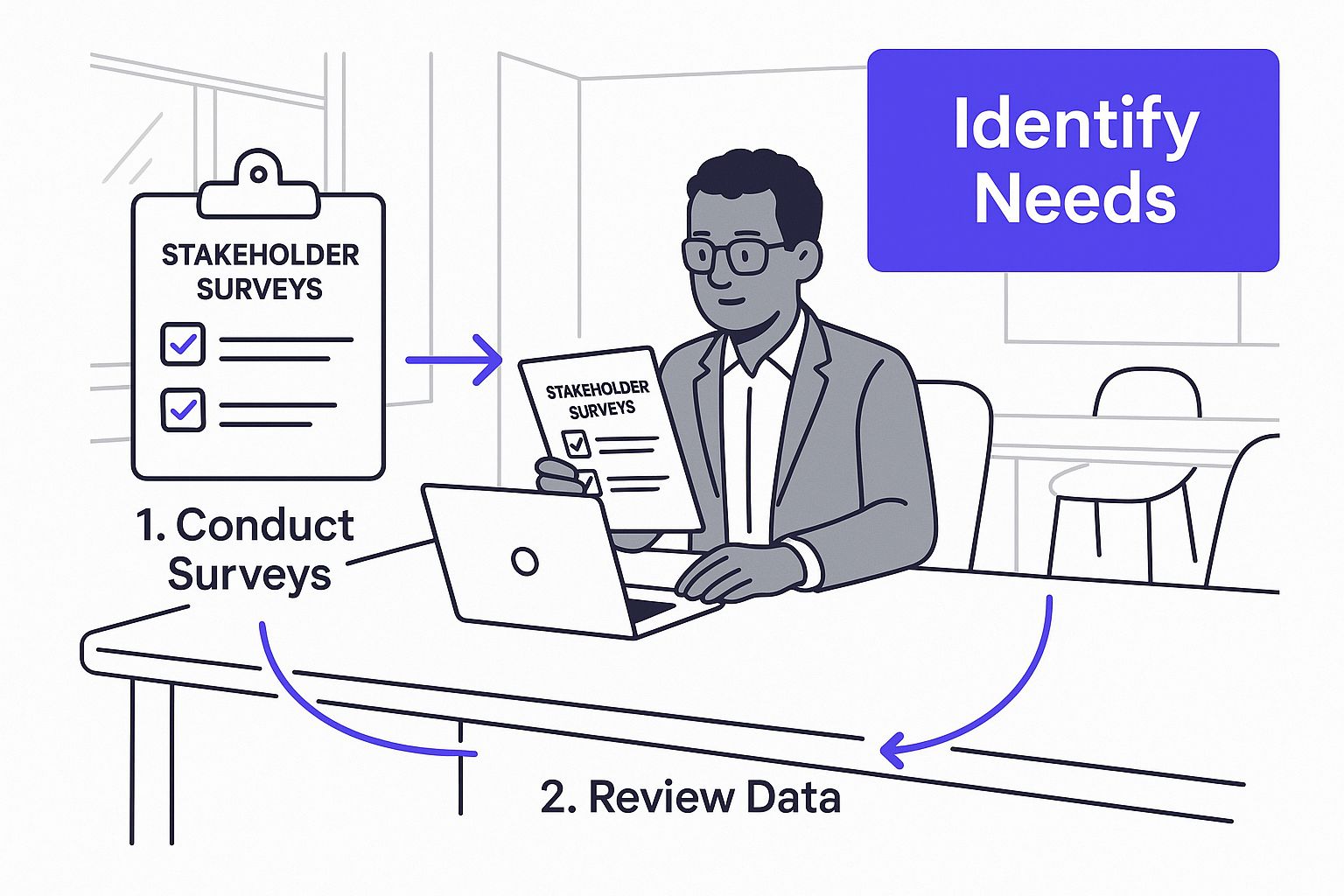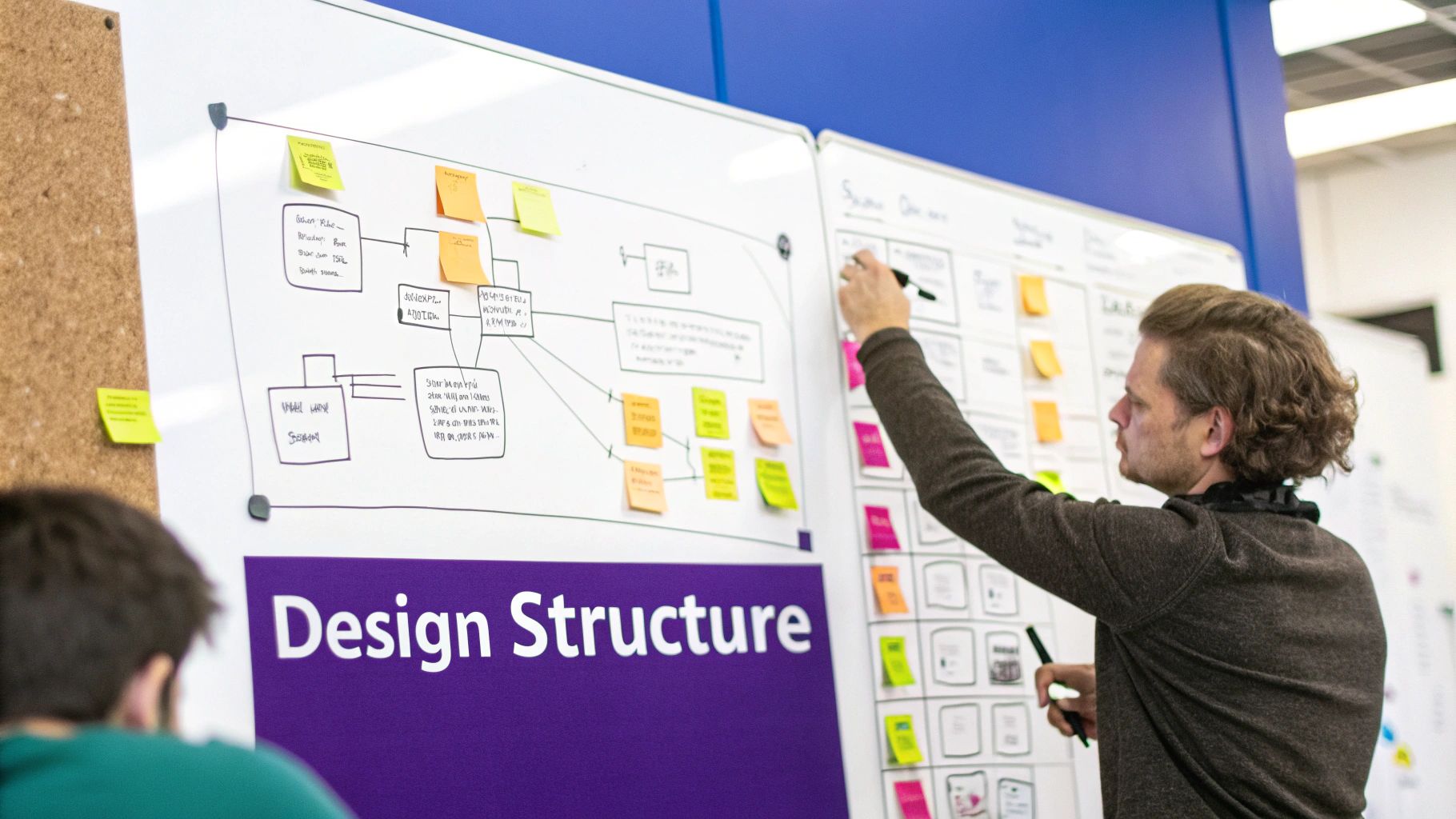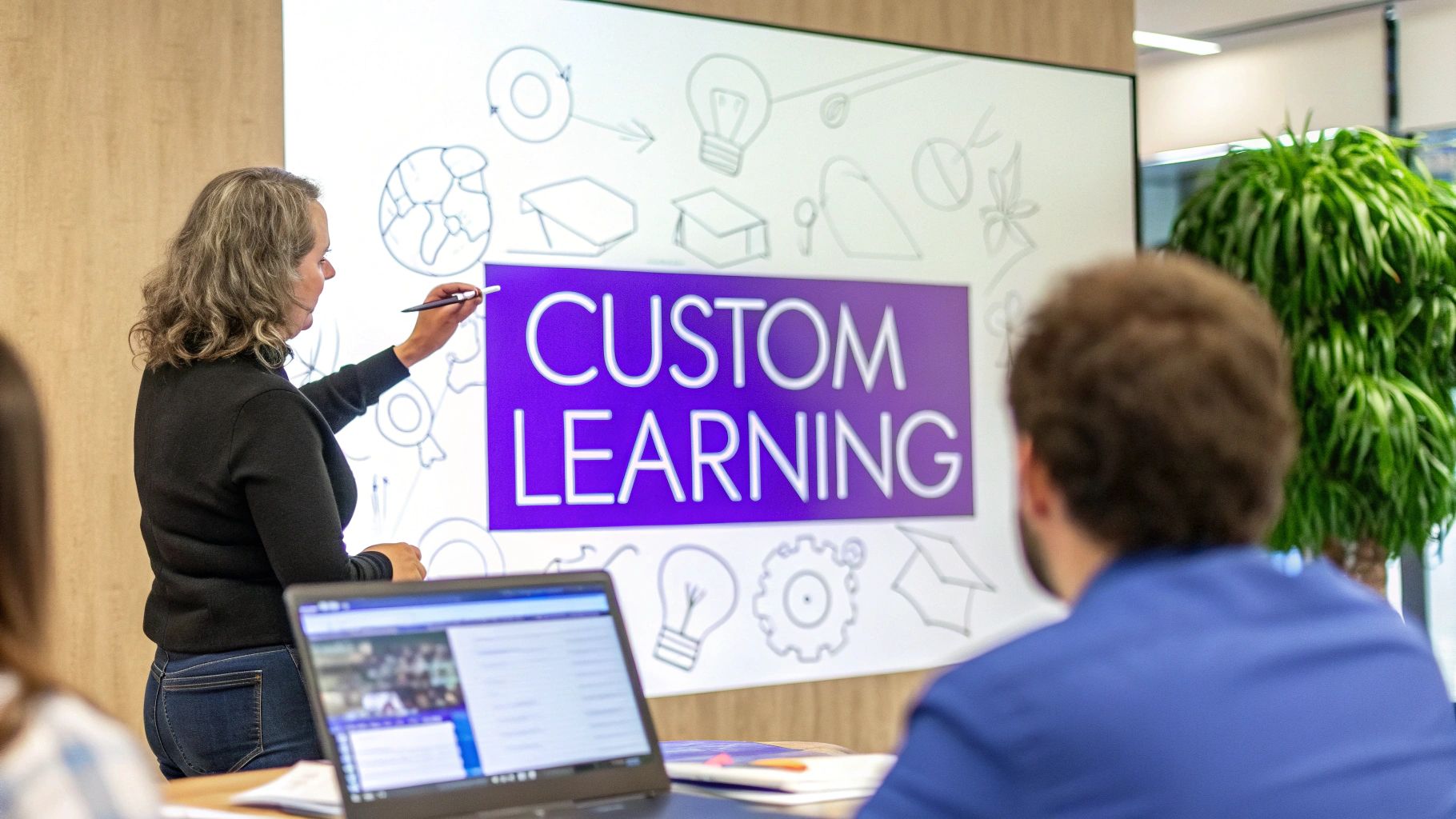Why Organizations Are Abandoning One-Size-Fits-All Training
Generic training programs often miss the mark when it comes to meeting the specific needs of modern businesses. This is prompting many organizations to rethink their approach to employee development. They're shifting budgets away from off-the-shelf training solutions and toward custom course development. This personalized approach allows companies to craft learning experiences that directly address their unique challenges and capitalize on their specific opportunities.
For example, a company specializing in sustainable energy might require training on particular regulations and technologies not found in generic courses. This shift is driven by a growing awareness that employee training should be a strategic investment, not just a box to check.
Forward-thinking organizations understand that tailored learning experiences are more effective in closing specific performance gaps. Furthermore, custom courses can be designed to perfectly align with strategic initiatives. This ensures employees develop the precise skills needed to achieve organizational goals.
Addressing Specific Needs Through Customization
One of the key benefits of custom course development is its ability to address the specific needs of a particular organization. While sometimes cost-effective upfront, off-the-shelf solutions often lack relevance and impact. They may cover general concepts but fail to explore the nuances specific to a company’s industry, processes, or internal culture.
This can leave employees without the specific skills they need to truly excel in their roles. Organizations are increasingly moving away from generic training programs. For insights into current best practices, check out these employee training best practices.
Custom courses can also be designed to reflect the unique culture and values of an organization. This fosters a stronger sense of connection among employees and reinforces the company's identity. This tailored approach leads to a more engaging and meaningful learning experience, which improves both knowledge retention and practical application.
The global eLearning market, which includes custom course development, was valued at $399.3 billion in 2022 and is expected to grow at a CAGR of approximately 14%. This growth underscores the increasing demand for tailored learning experiences. You can delve deeper into this topic here.
Custom Course Development: A Strategic Investment
Initially, custom course development might seem like a substantial investment. However, when weighed against the long-term costs of ineffective training, it often proves to be a wiser financial decision. Consider the expenses tied to employee turnover, low productivity, and errors stemming from inadequate training. These costs can easily surpass the initial investment in custom-developed courses.
Comparing Off-the-Shelf and Custom Solutions
To help illustrate the differences, the following table compares off-the-shelf and custom-developed courses across several key factors.
| Factor | Off-the-Shelf Solutions | Custom Course Development |
|---|---|---|
| Relevance | Generic, may not address specific needs | Directly addresses specific company needs |
| Engagement | Can be less engaging | More engaging and interactive |
| Cost | Lower upfront cost | Higher upfront cost, but potentially higher ROI |
| Flexibility | Limited customization options | Highly customizable |
| Alignment with Goals | May not align with specific goals | Directly aligned with organizational goals |
This table summarizes the core distinctions between the two approaches, highlighting the advantages of customization in addressing specific needs and achieving better alignment with business objectives.
By investing in custom course development, organizations ensure their training programs are not only effective but also directly contribute to their overall business goals. This empowers employees with the precise skills and knowledge they need to thrive, leading to improved performance, increased productivity, and ultimately, a stronger bottom line.
The Anatomy of Truly Effective Custom Learning
What makes custom course development a worthwhile investment? It's the careful blending of key elements that transforms learning from passive reception into active engagement and growth. This personalized approach stands in stark contrast to generic, off-the-shelf training, which often misses the mark in connecting with learners and producing measurable improvements.
Identifying True Learning Needs
Effective custom course development begins with a deep understanding of both the learner and the organization's goals. This goes beyond simply identifying surface-level skill gaps. It necessitates a comprehensive needs analysis to pinpoint the root causes of performance challenges. This often involves gathering data from multiple sources, such as surveys, interviews, and performance reviews.
These insights empower instructional designers to craft learning experiences that address the underlying issues, not just the symptoms. This ensures that the training is targeted and relevant, leading to lasting improvements in performance.

By analyzing feedback from sources like surveys, organizations gain valuable insights into existing knowledge gaps, learner preferences, and desired outcomes. This data-driven approach ensures the custom courses are precisely targeted to achieve measurable improvements in performance and directly address the identified needs. Custom course development starts with a clear understanding of what learners need to know and how that knowledge translates into improved on-the-job performance.
Collaboration Between Experts
Creating truly effective learning requires a close partnership between subject matter experts and learning designers. Subject matter experts bring in-depth knowledge of the content. Learning designers bring expertise in instructional design principles and adult learning theory.
This collaboration guarantees that the learning materials are accurate, relevant, and engaging, balancing technical depth with effective teaching methods. For example, a learning designer can guide a technical expert in structuring complex information into digestible modules, incorporating interactive elements and practical examples to enhance learning. The combined expertise results in learning content that resonates with learners while achieving desired results.
To illustrate the process, let's look at a breakdown of custom course development:
The Custom Course Development Process: A breakdown of the key phases, deliverables, and stakeholder involvement in a successful custom course development project
| Phase | Key Activities | Deliverables | Stakeholder Involvement |
|---|---|---|---|
| Needs Analysis | Surveys, Interviews, Performance Reviews, Data Analysis | Needs Assessment Report | Learners, Managers, Subject Matter Experts |
| Design | Learning Objectives, Content Outlines, Storyboarding, Prototype Development | Course Blueprint, Storyboard, Prototype | Learning Designers, Subject Matter Experts |
| Development | Content Creation, Multimedia Integration, Assessment Development | Course Modules, Assessments, Interactive Elements | Learning Designers, Subject Matter Experts |
| Implementation | Pilot Testing, Course Delivery, Learner Support | Launched Course, Learner Feedback | Learners, Trainers, Learning Designers |
| Evaluation | Data Collection, Performance Measurement, ROI Analysis | Evaluation Report, Recommendations for Improvement | Stakeholders, Learning Designers |
This table outlines the key phases of a typical custom course development project, highlighting the important activities, expected deliverables, and who's involved at each stage. This structured approach helps ensure a smooth and effective development process.
Focusing on Measurable Results
Custom course development isn't just about creating interesting content; it's about driving tangible results. This means defining clear learning objectives aligned with business goals. It also means incorporating assessment strategies that measure not just knowledge gained, but the practical application of that knowledge in real-world situations.
This focus on measurable results is crucial for demonstrating the value of training investments, refining future training programs, and ultimately, improving overall business performance. While immediate impact is important, long-term benefits like improved employee retention and increased innovation should also be considered when evaluating ROI.
How Leading Companies Transform Training Through Customization

This section explores how businesses are using custom course development to revitalize their training programs. We'll delve into real-world examples and examine the strategies these companies used to achieve remarkable results. These cases demonstrate the power of targeted learning in boosting key performance indicators.
Real-World Examples of Custom Course Development Success
Consider the case of a multinational tech company grappling with extended onboarding periods for new employees. By implementing role-specific simulations through custom course development, they achieved a 37% reduction in onboarding time. This not only saved valuable time and resources but also accelerated the integration of new hires into productive team members.
Another example involves a healthcare provider striving to elevate compliance scores and overall efficiency. Through custom-developed training focused on essential regulatory requirements and streamlined content delivery, they saw a substantial increase in compliance rates while simultaneously cutting training time in half. This targeted approach clearly delivered improvements in both compliance and efficiency. The corporate training sector, a global market valued at $361.5 billion in 2023, is projected to reach $805.6 billion by 2035. More detailed statistics can be found here. This growth is fueled in part by the increasing adoption of custom course development.
Overcoming Challenges and Securing Buy-In
Implementing custom course development often requires navigating internal obstacles. Securing buy-in from leadership is crucial. Many organizations initially express hesitation due to perceived costs. Overcoming this hurdle involves clearly demonstrating the return on investment (ROI) of custom training. This means showcasing how it can mitigate costs related to ineffective training, such as employee turnover and errors stemming from knowledge gaps.
Furthermore, some organizations voice concerns about the long-term sustainability of maintaining custom courses. Addressing these concerns requires building internal capacity for ongoing customization and incorporating easily updatable modules. By emphasizing the long-term advantages, companies can effectively showcase the lasting value of custom development.
Measuring Impact Beyond Completion Rates
Simply monitoring course completion rates doesn't provide a comprehensive view of training effectiveness. Leading companies assess the true impact of custom course development by linking learning outcomes directly to business metrics. For instance, the tech company mentioned earlier didn't just track onboarding completion; they also measured the time required for new hires to achieve full productivity. Likewise, the healthcare provider monitored how enhanced compliance scores affected overall patient care and safety.
Building Internal Capacity for Sustainable Customization
Organizations successfully implementing custom course development frequently invest in nurturing internal capabilities to facilitate ongoing updates and revisions. This may involve equipping staff with skills in instructional design principles, providing access to content creation tools like Articulate 360, or leveraging learning management systems (LMS) such as Moodle. By developing this internal expertise, businesses can adapt their training programs swiftly and cost-effectively as needs evolve. This ensures training materials stay relevant and impactful.
Cultivating in-house expertise empowers companies to take greater ownership of their training programs, ensuring alignment with changing business goals and technological advancements. This proactive approach equips employees with the essential skills and knowledge to thrive in a dynamic environment. This sustainable approach to custom development ensures long-term value and adaptability.
Leveraging Technology to Create Personalized Learning Experiences
Technology offers a wealth of tools to enhance custom course development, moving beyond the basics of eLearning and opening up exciting new ways to engage learners. These advancements don't always require a huge financial investment, but they can significantly boost the effectiveness of your training programs. Let's explore how organizations are using technologies like AI, VR, and mobile learning to create more impactful learning experiences. For more context on the importance of technology in personalized learning, check out this article on Web Development.
AI-Powered Adaptive Learning
Artificial intelligence (AI) is becoming increasingly important in personalized learning. A key application of AI is the development of adaptive learning paths. These paths adjust based on how each individual learner is performing. For instance, if a learner is struggling with a specific concept, the system can automatically offer them additional resources or practice exercises.
On the other hand, learners who quickly grasp concepts can be given more challenging material. This prevents boredom and keeps them engaged with the learning process. For a deeper dive into this topic, see How to master personalized learning paths.
Immersive Learning With VR
Virtual Reality (VR) offers truly immersive training experiences, which are especially valuable for developing important skills in a risk-free environment. Imagine a surgeon practicing a complex procedure in a VR operating room, or a pilot navigating difficult flight conditions in a virtual cockpit.
VR allows learners to hone crucial skills without real-world consequences. This makes it perfect for practicing procedures where mistakes could be costly or even dangerous.
Mobile Microlearning for Reinforcement
Mobile microlearning delivers short, focused bursts of learning content straight to learners' smartphones or tablets. This method reinforces training right when employees need it most. A sales representative, for example, could quickly review product features before a client meeting.
A technician could access troubleshooting steps during a service call. This just-in-time delivery maximizes knowledge retention and practical application.
Choosing the Right Technology for Your Needs
It’s important to remember that not all technologies are equal. Some offer real learning advantages, while others just add superficial elements without any real substance. You need to carefully evaluate which technologies will truly enhance the learning experience and align with your specific goals.
Consider factors like your target audience, your budget, and the type of content you're delivering when choosing the right technological tools for your custom course development. This strategic approach ensures the technology serves a real purpose and leads to measurable improvements in learning outcomes.
Implementation Challenges and Compatibility
While technology can significantly improve learning, it’s crucial to be aware of potential implementation challenges. Compatibility issues can arise when integrating new technologies with existing systems. It’s also important to ensure accessibility for all learners, as not everyone will have the same level of technical skill or access to the same devices.
Addressing these challenges proactively through careful planning and testing is essential for a successful implementation.
The Future of Custom Course Development
These technological advancements are changing the face of organizational learning, and offering exciting new possibilities. As technology continues to evolve, we can expect even more personalized and engaging learning experiences. This will drive greater effectiveness and impact in the future of custom course development.
This constant evolution will enable organizations to create learning programs that are perfectly suited to the needs of their employees and their specific business objectives.
Building Skills That Matter: Custom Vocational Training

The skills gap presents a significant hurdle for many industries. Generic training programs often miss the mark, failing to equip workers with the specific skills employers need. Custom course development offers a solution, tailoring vocational and technical training to meet precise job requirements. This targeted approach prepares workers for specialized roles far more effectively than traditional, one-size-fits-all training methods.
Custom course development empowers training providers to design programs that directly address industry-specific skill demands. This ensures graduates possess the exact competencies employers seek, making them immediately valuable assets. For example, a manufacturing company might collaborate with a training provider to create a custom course on operating their specialized machinery. This targeted training gets new hires proficient quickly, minimizing onboarding time and boosting productivity.
Additionally, custom courses can incorporate real equipment simulations. These simulations provide a safe environment for trainees to practice and hone their skills before working with live equipment. This hands-on experience bridges the gap between theory and application, making graduates more attractive to potential employers. For guidance on creating training outlines, check out this helpful resource: creating a sample training outline.
Partnering for Success: Organizations and Educational Institutions
Many organizations are now partnering with educational institutions to develop custom training pathways. These collaborations blend academic knowledge with practical, hands-on experience. Learners can apply classroom concepts to real-world scenarios, significantly enhancing their skill development. These partnerships also benefit educational institutions by aligning their curriculum with current industry needs, ensuring their graduates are highly employable.
Authentic Assessment: Measuring True Job Readiness
Custom course development facilitates the use of authentic assessment methods. Instead of relying solely on traditional, memorization-based tests, authentic assessment focuses on practical application. Trainees demonstrate their skills through simulations, projects, or performance-based tasks that mirror actual job duties. For example, an electrician trainee might be assessed on their ability to wire a circuit board, rather than simply taking a multiple-choice exam. This approach provides a more accurate measure of job readiness.
The vocational training market, valued at $388.1 billion in 2024, is projected to reach $648.9 billion by 2030. This significant growth underscores the increasing demand for specialized training. Learn more about the expanding vocational training market here. Custom course development is key to meeting this demand by providing flexible and adaptable learning solutions.
Adapting to Evolving Industry Needs
A major benefit of custom course development is its adaptability. As industries evolve and new technologies emerge, training programs must adapt. Custom courses can be easily updated to reflect these changes, ensuring learners acquire the most relevant and up-to-date skills. This flexibility is essential for preparing individuals for successful careers in today’s dynamic and rapidly changing job market. This responsiveness makes custom course development an invaluable tool for empowering the workforce of the future.
Proving the Worth: Measuring Custom Course Development ROI
How can you tell if your investment in custom courses is paying off? This section dives into establishing measurement frameworks that link training to real business results, going beyond simple learner satisfaction surveys. We'll explore how successful organizations track both the immediate effects and the long-term impact of their custom training programs. For more information on pricing strategies, check out this helpful resource: How to price online courses.
Connecting Training to Business Outcomes
Organizations that see real value from their training understand the importance of tying learning outcomes to business results. This involves defining clear metrics that reflect the training's impact on important Key Performance Indicators (KPIs).
For instance, a custom course aimed at improving customer service skills could be evaluated by monitoring metrics like customer satisfaction scores and resolution times. This provides tangible proof of the training's effectiveness.
Calculating Financial Returns
Demonstrating Return on Investment (ROI) is often best achieved by calculating the financial returns of custom course development. This can be measured through improvements in performance, error reduction, and productivity.
Let's say a custom safety training program leads to a decrease in workplace accidents. The resulting cost savings from fewer insurance claims and lost workdays can be directly linked to the training investment.
Data Visualization for Effective Communication
Clearly presenting data is key to communicating the impact of training. Executives and decision-makers often prioritize business results over learning metrics. Visualizing data with charts and graphs, illustrating how custom courses have improved KPIs, strengthens the argument for continued training investment.
A simple line graph showing a decrease in customer support calls after a custom product knowledge course can powerfully demonstrate the training's positive effects.
Establishing Realistic Timelines
Setting realistic timelines for measuring different training outcomes is essential. Some outcomes, like knowledge gained, can be measured quickly. Others, like behavior change and organizational impact, may take longer to appear.
Recognizing these different timelines sets proper expectations and allows for a more accurate assessment of the training's effectiveness. A new software training program, for example, may show immediate knowledge gains, but real improvements in employee productivity using the software might take weeks or even months.
Immediate Indicators vs. Long-Term Impact
When measuring ROI, look at both immediate indicators and long-term impact. Immediate indicators might include improved test scores or increased learner engagement. Long-term impact could involve metrics like reduced employee turnover or increased sales.
Tracking both short-term and long-term outcomes offers a complete picture of the training's effectiveness. A custom leadership development program might show improved communication skills among participants right away, while over time, it could lead to increased team performance and innovation.
Case Studies and Expert Insights
Looking at case studies of other organizations can be highly informative. Seeing how others have effectively measured their custom course development ROI provides useful benchmarks and best practices.
Furthermore, advice from learning and development experts can offer valuable guidance on selecting the right metrics, structuring effective measurement frameworks, and conveying the value of training to stakeholders.
By focusing on these measurement strategies, you can validate the value of your custom course development and demonstrate its impact on achieving significant business results.
Launch Custom Courses Seamlessly with Tevello on Shopify
Generic, off-the-shelf training might check a box - but it rarely delivers long-term value. Custom courses, on the other hand, let you speak directly to your audience’s needs, adapt to their pace, and reflect your brand’s unique expertise.
But here’s the challenge: delivering that kind of tailored experience can feel overwhelming when you're piecing it together with multiple tools that don’t talk to each other.
That’s exactly why Tevello was built - to take the friction out of course creation by giving you everything you need right inside your Shopify store.
No need to integrate yet another platform. No juggling content, access settings, or customer data across different systems. Tevello simplifies it all.
Whether you're building a team training hub, onboarding series, or educational content to support your products, Tevello gives you the structure, flexibility, and control to do it right - without the tech stress.
If you're looking to grow with intentional, high-impact learning experiences, Tevello is your all-in-one solution to create and sell courses seamlessly, right where your business already lives.




